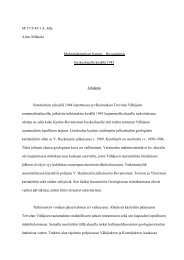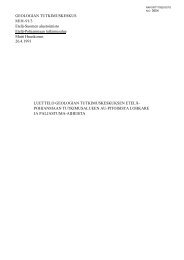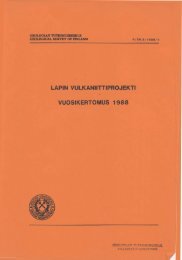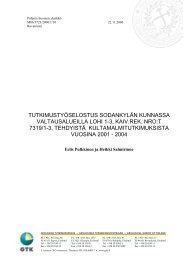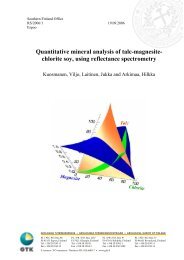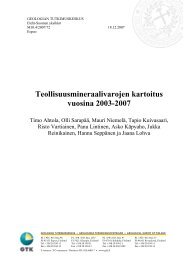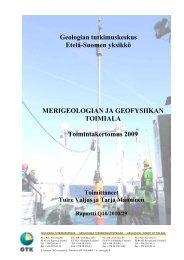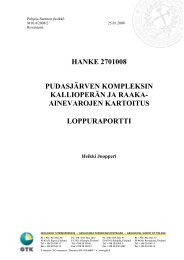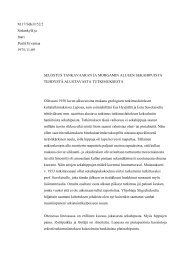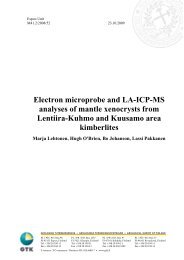Suomen geologinen kartta 1 : 100 000, Kallioperäkarttojen selitykset, lehdet 1041 ja 1043Ritva Karhunenthat the upper part of the volcanic succession was deposited subaerially. Layers ofcrystalline limestone intercalated with the gneisses and amphibolites are common.After sedimentation and volcanism synorogenic magmas intruded the supracrustalrocks. The age of the granodiorites, tonalites, trondhjemites and gabbros is 1890–1870 Ma (Patchett & Kouvo 1986). Coarse-grained granitic rocks intruded duringthe lateorogenic stage (1840–1820 Ma; see Suominen 1991). Locally, strong demormationaccompanied the intrusion of the K-rich granites.The presence of garnet and cordierite in the mica gneisses indicates metamorphicconditions of upper amphibolite facies. However, in the Iniö map area, especiallyin the province of Åland, garnet is sparce and no cordierite has been found.This suggests decrease in metamorphic grade towards the west. This assumption isalso con<strong>fi</strong>rmed by Väisänen & Hölttä (1999) in their studies from the Turku area.According to them the metaomorphic grade rises from NW towards SE, from cordierite-K-feldspargneisses to high temperature granulites.Around 1800 Ma ago the postorogenic Åva granite with associated lamprophyricdykes were emplaced. The Subjotnian diabase dykes intruded ca. 1600 Ma ago.The rapakivi granites of Fjälskär (1579±13 Ma; Suominen 1991) and pyterlite ofVehmaa (1582±4 Ma; Lindberg & Bergman 1993) were emplaced slightly after thediabase dykes. The 1800 Ma and 1600–1570 Ma events record bimodal magmatismthat resulted from melting at the base of the crust.SHEAR ZONESThe low-altitude aeromagnetic map over the map-sheets of Iniö and Turku is appended(Appendix 1). The Åva ring complex and the Fjälskär granite intrusion showup as roundish positive (red) anomalies in the Iniö map-sheet area. The shear zonesin the archipelago are seen as narrow negative (blue) anomalies; the most distinctones trend north to northeast. The Airisto shear zone in the Turku map-sheet areasplits southwards into two zones, one trending south and the other southwest alongthe eastern coast of the Airismaa island towards Aaslaluoto and further southwest.In the western part of the Iniö map-sheet the Kihti shows up as a broad negativeanomaly with a trend to the north. The northeast-trending positive anomalies betweenthe Åva and Fjälskär intrusions are caused by a swarm of diabase dykes.ECONOMIC OCCURRENCESLimestone is the most signi<strong>fi</strong>cant mineral resource in the both map-sheet areas.In the Turku map-sheet area the limestone quarry in Parainen is the largest in Finland.The limestone was utilized already in 1700th century. Especially in the 1800thcentury mineralogists noticed the rare minerals, such as skapolite, chondrodite andpargasite, associated with the limestone. In the Iniö map-sheet area some limestonehas been quarried during 1960–1970 in Åvensor, in the Korppoo community.Small amounts of iron ore has been locally quarried in some parts of the archipelago.70
Suomen geologinen kartta 1 : 100 000, Kallioperäkarttojen selitykset, lehdet 1041 ja 1043Iniön ja Turun kartta-alueiden kallioperä – Berggrunden inom Iniö och Åbo kartbladKIRJALLISUUTTA – LITTERATUR – LITERATUREArth, J. G., Barker, F., Peterman, Z. E. & Friedman, J. 1978. Geochemistry of the gabbro– diorite – tonalite – trondhjemite suite of the Southwest Finland and its implications forthe origin of tonalitic and trondhjemitic magmas. Journal of Petrology 19 (2), 289–316.Bergman, L. 1971. Två anorogena graniters inverkan på omgivningens tektonik. Geologi 23(1), 3-4.Bergman, L. 1972. Skårskärin kallioiden rapautumisesta Houtskarissa Lounais-Suomen saaristossa.Pro gradu -tutkielma, Turun yliopisto. 40 s. + 4 liitettä.Bergman, L. 1973. Två granitplutoners inverkan på den omgivande berggrundens tektonik,Åva- och Fjälsärgraniterna, SW Finland. Pro gradu -avhandling, Åbo Akademi. 69 s. +4 liitekarttaa.Bergman, L. 1986. Structure and mechanism of intrusion of postorogenic granites in thearchipelago of southwestern Finlad. Acta Academiae aboensis. Ser. B, Mathematica etPhysica 46 (5), 1–74.Boström, R. 1951. Porfyrgraniten vid Åva, Brändö, Åland, samt bergarterna förbundna medoch omgivande densamma. Pro gradu -avhandling, Åbo Akademi. 82 s.Branigan, N. P. 1986. The geology, geochemistry, and tectonic setting of the early-postorogenicring complexes, Åland, S.W. Finland. Dundee: University of Dundee. 584 s. + 2 liitekarttaa.Branigan, N. P. 1989a. Internal deformation, flow pro<strong>fi</strong>les and emplacement velocities ofgranitic dykes, southwestern Finland. Lithos 22 (3), 199–211.Branigan, N. P. 1989b . Hybridisation in middle Proterozoic high-level ring complexes,Åland, SW Finland. Precambrian Research 45 (1–3), 83–95.Bremer, C. O. 1824 Anvisningar på Malm och Bergarter uti Stor-Furstendömet Finland. DelI. Åbo (Turku) 1824. s. 1-178. Del II. Åbo (Turku) 1825, s. 1–263.Duin, J. A. van 1992. The Turku granulite area, SW Finland: a fluid-absent Svecofenniangranulite occurrence. Amsterdam: Vrije Universiteit. 234 s.Duin, J. A. van & Nieman, C. P. 1993 . Pressure and temperature history of a low-pressuretransitional granulite area, Turku, SW Finland. Geologie en Mijnbouw 71 (3), 259–280.Edelman, N. 1949. Structural history of the eastern part of the Gullkrona basin. Bulletin de laCommission géologique de Finlande 148. 48 s.Edelman, N. 1960. Gullkrona region, SW-Finland. Bulletin de la Commission géologique deFinlande 187. 87 s.Edelman, N. 1972. Amygdaloidal spilitic dikes in Houtskär, SW Finland. Bulletin of theGeological Society of Finland 44 (2), 103–106.Edelman, N. 1973. Nagu. Suomen geologinen kartta – Geological map of Finland 1 :100 000,kallioperäkartta – Pre-Quaternary Rocks, lehti – Sheet 1034. Geologinen tutkimuslaitos.Edelman, N. 1985. Nauvon (Nagu) kartta-alueen kallioperä = Berggrunden inom Nagu (Nauvo)kartblad. Summary: Pre-Quaternary rocks of the Nauvo (Nagu) map-sheet area. Suomengeologinen kartta – Geological Map of Finland 1 : 100 000, Kallioperäkarttojen selitykset– Explanation to the Maps of Pre-Quaternary rocks, lehti – Seet 1034. <strong>Geologian</strong> <strong>tutkimuskeskus</strong>.47 s.Edelman, N., Ehlers, C. & Suominen, V. 1975. Ahvenanmaa – Åland. Kivilajikartta – Bergartskarta– Pre-Quaternary Rocks, Suomen geologinen yleiskartta – Geologisk översiktskartaöver Finland – General Geological Map of Finland 1 : 400 000, lehti – Sheet A1.Geologinen tutkimuslaitos.Edelman, N. & Jaanus-Järkkälä, M. 1983. A plate tectonic interpretation of the Precambrianof the Archipelago of southwestern Finland. Geological Survey of Finland, Bulletin 32.33 s.Ehlers, C. & Bergman, L. 1984a. Strukturer och intrusionsmekanismer hos två rundade postorogenagranitmassiv i SW Finland. Julkaisussa: Armands, G. & Schager, S. (toim.) 16eNordiska Geologiska Vintermötet, Stockholm 9–13 januari 1984. Abstracts. Meddelandenfrån Stockholms universitets geologiska institution 255. 54.Ehlers, C. & Bergman, L. 1984b. Structure and mechanism of intrusion of two postorogenicgranite massifs, southwestern Finland. Julkaisussa: Kröner, A. & Greiling, R. (toim.) Precambriantectonics illustrated. Stuttgart: E. Schweizerbart’sche Verlagsbuchhandlung, 173–190.71



